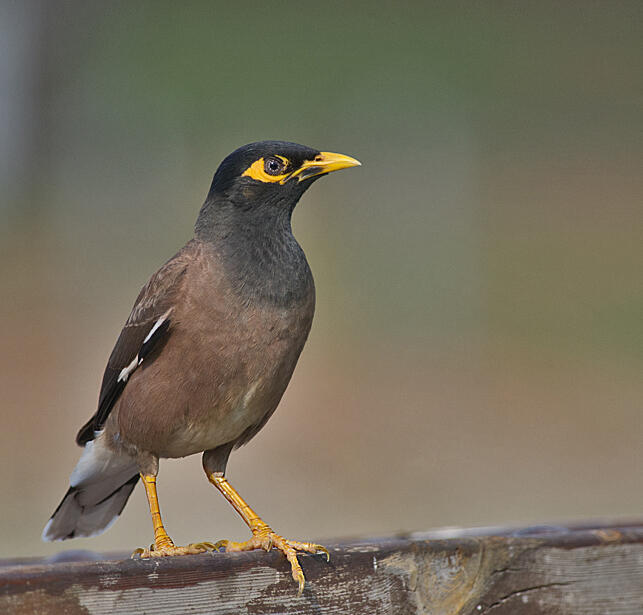Getting your Trinity Audio player ready...
The gray crow (Corvus cornix) remains Israel's most ubiquitous bird, narrowly beating the common myna (Acridotheres tristis) and the rock pigeon (Columba livia). These findings are based on the 2025 Great Bird Count, published on Tuesday.
The gray crow was reported in 61.7% of observations, the common myna in 57.9%, and the rock pigeon in 53.8% of reports from across the country. The laughing dove (Spilopelia senegalensis) ranked fourth, followed by the rose-ringed parakeet (Psittacula krameri). Completing the top ten were the spectacled bulbul (Pycnonotus xanthopygos), house sparrow (Passer domesticus), Palestine sunbird (Cinnyris osea), great tit (Parus major), and blackbird (Turdus merula).
A comparison of the prevalence of these top ten species with previous years shows an increase in reports of the common myna and the rose-ringed parakeet, both invasive species gradually expanding their range. Meanwhile, the gray crow and rock pigeon populations have remained relatively stable. However, the house sparrow and spectacled bulbul show a declining trend, despite a slight increase in their reports over the past year.
Regional differences were noted in the distribution of bird species. In northern Israel, the gray crow was the most common species, followed by the rock pigeon and the common myna. In the central region, the common myna led, followed by the gray crow and the rose-ringed parakeet. In the south, the house sparrow was the most commonly observed bird, followed by the rock pigeon and the laughing dove. The gray crow ranked fourth in the south, just ahead of the common myna.
This year’s bird count received 1,400 reports, an 11% increase compared to 2024. Nearly 52,000 birds representing 144 species were documented in this 20th annual count. The initiative is managed by the Israeli Center for Citizen Science at the Steinhardt Museum of Natural History, Tel Aviv University, in collaboration with the Society for the Protection of Nature in Israel and the Center for the Promotion of Urban Birds.
The bird count aims to provide an updated picture of bird populations in urban and inhabited areas (such as industrial zones, rehabilitation villages, and military bases), identify changes in species distribution, and collect data for future scientific research. Additionally, it promotes initiatives that benefit birds and connects the public with nature, offering participants enjoyment, inspiration, and peace of mind.
Reports were received this year from 204 communities, compared to 182 in 2023 and 179 in 2024. Notably, there was a significant increase in observations from southern communities (52%) and northern communities (56%) compared to last year. Tel Aviv led the count with 175 observations.
Organizers explained that the frequency of each bird species was calculated by dividing the total number of reports by the number of reports in which the species appeared. This methodology provides an estimate of the likelihood of encountering specific species. For data analysis, only reports from 2019 onward were used, when data collection via the eBird app began, allowing precise data on location, duration, and observation range.
To maximize the number of reports included, only observations conducted in inhabited areas, lasting between 5 and 15 minutes, and within a range of less than 300 meters, were selected. Due to these filtering criteria, some differences may appear compared to results from previous reports.
Hundreds of citizens participated in the bird count, ranging from kindergarten children to retirees, who shared their experiences of involvement, learning, and enjoyment. However, challenges were noted, including difficulties identifying species, misidentifications of moving or flocking birds, unfavorable weather conditions, and a lack of sightings in some cases. Organizers suggested that tools like the Merlin app could help address these challenges.
This year, several new initiatives were launched as part of the project. A new song about the hoopoe (Upupa epops), Israel’s national bird (which did not make the top ten), was created as part of the “Living Legend” project by musician Shahar Even Tzur in collaboration with the Museum of Natural History. Another initiative, “Feather,” was introduced to complement the bird count by monitoring bird activity in urban areas throughout the year. Amateur birdwatchers are invited to join this effort.
Get the Ynetnews app on your smartphone: Google Play: https://bit.ly/4eJ37pE | Apple App Store: https://bit.ly/3ZL7iNv
Additionally, the “Bird Count Ambassadors” program was launched for the first time. Veteran volunteers conducted workshops and training sessions across the country, involving over 250 participants. These activities, held voluntarily in kibbutzim, urban parks, and community gardens, aim to further engage the public with birdwatching.
In 2024, an in-depth study analyzed the development of the bird count initiative, dividing it into three main stages. The study examined changes in leadership structure, data collection protocols, reporting methods, and data analysis. Its findings provide a foundation for strengthening and improving the bird count in the future.




